Your cart is currently empty!
Can you Mix Different Types of Glaze? – Combining Glazes
Published:
Last Updated:
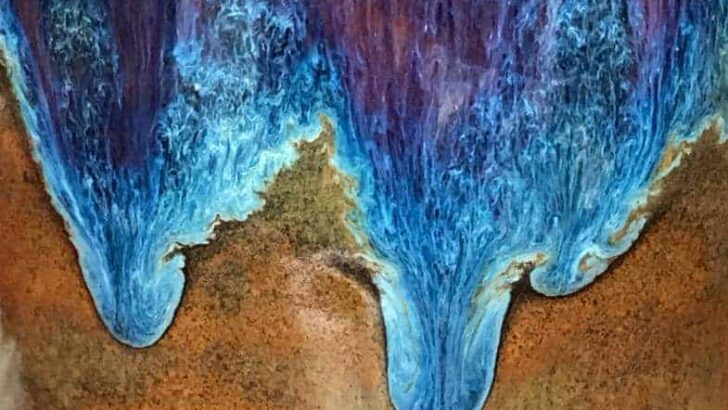
Affiliate Disclaimer
As an affiliate, we may earn a commission from qualifying purchases. We get commissions for purchases made through links on this website from Amazon and other third parties.
I sometimes find myself in a position where I don’t have the exact color glaze that I want. Recently I wondered if I could mix different types of glaze together and what would happen. So, I looked into the question of combining glazes and this is what I have found….
You can mix different types of glaze by layering or blending. Some glazes are not compatible. This can cause blistering, crawling, and flaking. The mixed glaze may also be less stable and prone to leaching. These problems are less likely if you are mixing glaze from the same manufacturer and range.
There is a dizzying array of glazes available to buy. And many different brands manufacture their own lines of glazes. Within each range, there are many different colors.
This article will look at the options of mixing different types of glaze that are within the same brand. And also, what you can do if you want to mix glaze from different brands.
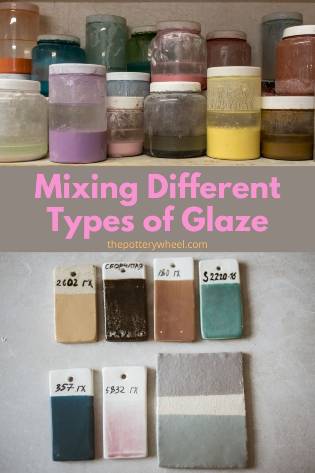
Layering Glazes Versus Mixing Glazes Together
There’s a difference between layering glazes on a piece and mixing two glaze colors together to make a third color.
Layering involves putting a coat of glaze onto your pottery, then applying further layers of a different color on top. Mixing involves actually blending two or more colors together and applying the resulting glaze to your piece in one layer.
Layering Glazes
These two processes have different results. When I first started glazing I wasn’t even sure if it was ok to layer different colored glazes. Well, the short answer to that question is that you can. It’s ok to add more than one color glaze to your pottery. What this looks like when it’s fired, will depend on the glaze you use.
Some glazes are static, which means that they will stay pretty much in the same place that you applied them. Other glazes are called flowing glazes and move quite a bit when they are fired. If you layer flowing glazes they will often blend and blur into one another when they are fired.
Many manufacturers will specify that glazes within a particular range are particularly suitable for layering. In fact, they will give recommendations about what colors work well together. One example of this is the Potters Choice range from Amaco.
When glazes are layered they interact chemically when they are fired. In some ranges, this interaction will cause new colors to be created on a piece.
For example, layered glazes that are brown and blue might create a pink or purple accent on your piece. Potters Choice glazes are a good example of this kind of flowing glaze.
Mixing Glazes
Mixing glazes to make a new color is a different process. The color of glaze before it is fired is different from how it looks once it’s been in the kiln. If you mix two glaze colors together, it’s hard to predict what the resulting color will look like.
What’s more, mixing glazes is not like mixing paint. With paint, you know that if you mix certain colors you will produce a particular hue as a result. For example, blue mixed with red creates purple, right? Well, this is not always the case with glazes.
When glazes are fired, they undergo significant chemical changes. So, if you mix different colored glazes you can end up with some surprising results.
If you are mixing different colored glazes for the first time, it’s a good idea to do a test tile first. This will allow you to see what color the fired glaze will be.
When mixing different colored glazes there is a higher chance that you will end up with a muddy brown color. So, testing your glaze is key before committing it to your ware.
There are other important factors to consider if you want to mix different types of glaze. These factors are, firstly, whether the glazes you want to mix are from the same range by a particular manufacturer.
And secondly, if the glazes fire at the same temperature. Let’s take a look at these two factors now…
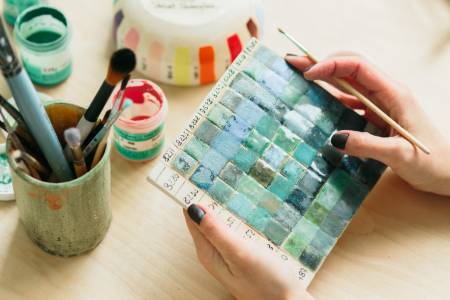
Can you Mix Different Types of Glaze in the Same Range?
Some glaze manufacturers will specify that glazes within a particular range are particularly designed to be layered and even mixed. If that is the case, then you can mix different types of glaze without too much worry.
Bear in mind that whilst some color combinations will work well, some will turn out muddy. If you want to try mixing glazes you need to be prepared to invest some time testing out your color combinations. Unless of course, you are willing to take a chance with your pottery and see how it turns out.
The other thing to be aware of is that glazes are carefully made by manufacturers to be stable. This means that when they are fired, the metals and compounds in the glaze are locked into the glassy surface.
If a glaze is not stable, then the glassy surface is vulnerable to corrosion. Certain foodstuffs, particularly acidic foods can dissolve the glaze surface and metals can leach out of the glaze.
When a glaze is labeled as being food safe, in part this means that the glaze is stable. It is worth remembering that by mixing glazes you are potentially altering their chemistry.
Mixing glazes can make them less stable. Two food-safe glazes mixed together do not necessarily create a food-safe combination.
If the manufacturer states that combining glazes will make a food-safe third glaze, then you are good to go. However, if this is not part of their glaze specification, it’s worth checking with the manufacturer first.
Can you Mix Different Types of Glaze in a Different Range?
If you want to mix different types of glaze in different ranges, it’s important to test the results first. Some glazes will work well together, others will interact with undesirable results.
It’s good to experiment. Mixing brands of glaze can work, particularly if they have the same properties. For example, layering glazes from the Spectrum 1100 range with Amaco Potters Choice glazes can work well.
It’s also possible to blend glazes from different brands together to create a new color. Sometimes this will work and you might stumble on a nice new color or texture. At other times the glazes will interact poorly with one another.
Glaze Interaction
If the glazes are not compatible, the sorts of problems the glazes might encounter are blistering, crawling, and flaking. It can be hard to predict which glazes will mix together successfully, and the only way to find out is to experiment.
Also, even if a mixture of glazes looks good once it’s fired, looking nice doesn’t mean it is food safe. Your glaze combination may not have obvious defects like crawling or blistering.
However, mixing different types of glaze can create an unstable hybrid. If a glaze is not stable it can leach metals into food and drink if it’s being used as dinnerware.
Glazes are formulated with care by manufacturers to ensure their stability. Mixing glazes, especially from different brands or ranges, increases the chance that this stability is being tampered with.
Most potters who mix glazes from different brands will use these glazed pieces as decorative rather than functional ware.
Alternatively, it is possible to get your glaze combination tested to check if it is food safe. This process is actually simpler than it sounds. You can simply send a sample of your pottery off to a lab that specializes in testing pottery glazes.
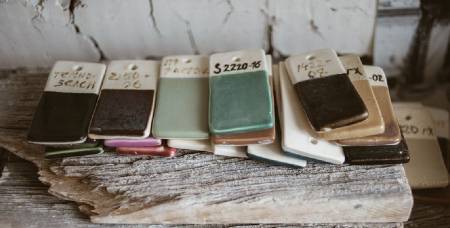
How to Mix Different Types of Glaze
If you want to mix different types of glaze, then here are some tips about how to test out your combinations:
- Try a range of percentages in your combinations. It’s helpful to create a test tile with different percentage mixes and keep this as a reference.
For example, you might try 10% of glaze A with 90% of glaze B. And try increasing the amount of glaze A by increasing increments of 10%.
Remember to keep a record of the combinations for future reference. You can write the combination on the back of the test tile with an underglaze pencil. - Try mixing more than two colors. You might find that three or more glaze colors will give you the exact shade you are looking for.
- Of course, the more colors you use, the more likely you are to end up with a pea soup color. But you might get lucky and find a lovely shade.
Eutectic Mixtures
Mixing glazes can create a “eutectic” mixture. This is when mixing two substances creates a compound that is more fluid than either of the two individual glazes. In short, the mixed glaze is runnier when it’s fired than the glazes that it’s made from.
Because of this, it’s a good idea to put a ledge or shelf on your test tile. The ledge will catch any glaze if it runs off your test tile whilst it’s being fired.
Use a kiln cookie under any ware that is glazed with a combination glaze. Again, this will catch any glaze that might run from your ware when it’s being fired.
The eutectic reaction can apply if you are layering glazes as well as blending them. So, if you are using layering a new combination, keep the layers on the top portion of your pottery.
If you only layer the top section of your ware, it’s unlikely to run onto the foot of your piece. This will help familiarize you with the combination.
If it doesn’t run too much, you can apply layers lower down on future pieces. But in the first instance, keep the layers towards the top of your ware.
Mixing High and Low-Temperature Glazes
Some glazes are supposed to be fired at low temperatures. Other glazes are designed to be fired in the mid or high range. The difference between these glazes has to do with the temperature at which they melt and mature.
For example, a mid or high fire glaze will most likely not form a glassy surface at a lower temperature. Having said that, some low fire glazes do cope with being fired at higher temperatures.
Low fire and mid or high fire glazes have different glaze chemistry. For that reason, there is a higher chance they will be incompatible if they are mixed to make a single glaze. You can experiment to see what results you get.
However, as mentioned, even if the resulting glaze mix looks good, you can’t assume that it is stable and food safe.
Using Low Fire and Mid/High Fire Glaze on One Piece
One way to use earthenware and stoneware glazes on one piece of ware is to glaze fire twice.
Maybe you have a nice bright low fire glaze that you want to use for details on your piece. Or perhaps you want to glaze the inside of a pot with one glaze and use another on the outside.
One way to do this is to apply the mid/high fire glaze first and fire it at stoneware temperature. Then apply the low fire glaze to your pot and glaze fire again at the lower temperature.
By glaze firing twice you can mix different types of glaze on one piece. If you use this approach it’s worth bearing in mind the following….
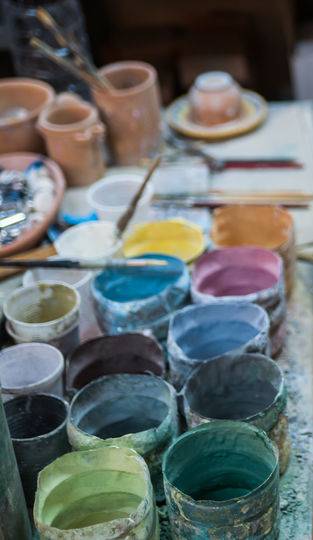
Firing Stoneware Glaze for a Second Time
- Choose a slower firing schedule on the second glaze fire. Firing slower the second time puts the clay under less stress.
- If you are firing to stoneware temperature on the first glaze fire, the clay will be vitrified. This means it will be non-porous. It can be hard to get glaze to adhere to vitrified clay. And if it does adhere it will take longer to dry.
You can help the low fire glaze stick to the mature clay in a few ways. One way is to warm your pottery up with a hairdryer. The glaze will dry onto the mature clay quicker if the clay is warm. For more tips on getting glaze to adhere to high fired clay, check out this article. - High fire glaze might look different when it has been low fired a second time. Sometimes this is a good thing. For example, colors that were muddy after a high fire might transform into bright red in a second low fire.
Whilst this might look nice, it may not be the effect you intended. Make a test tile to see what your stoneware glaze will look like after a low fire. Some high fire glazes won’t be altered by a second low fire glaze, but others will. If you want to know how your piece will look doing a test tile will help. - Some high fire glazes will tolerate a second low fire glaze well. However, sometimes you might get unwanted effects in the high fire glaze. An example is that your stoneware glaze might craze after it’s been fired a second time.
Alternatively, the high fire glaze might start to melt again when you fire it again. This is known as fluxing and can cause the high fire glaze to blister.
Applying Low Fire Glaze on Top of Higher Firing Glazes
There is a long tradition of decorating glazed ware with low fire glazes. These glazes are known as overglazes. The process involves painting decoration onto the glazed pottery and then firing again at a lower temperature. This is the technique behind luster glazing and china painting. It is also known as on-glaze decoration or overglaze enamel.
Final Thoughts
Fortune favors the bold and if you want to mix different types of glaze why not have a go? Finding the right color for you might be a case of trial and error. And it’s likely that some of your mixes will not turn out as you would like them. But if you’re lucky, you might just find a gem.



